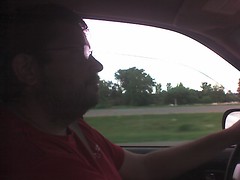While at breakfast (again, waffles, hard-boiled eggs, bagels, and OJ) I talked with some guests. Erin, visiting the Dunes from
 I checked out and thanked the wonderful staff at the Fairfield Marriott in Valparaiso (kudos to Jackie!) who provided a complimentary night’s stay. Here’s me heading out in the brightly sunny morning.
I checked out and thanked the wonderful staff at the Fairfield Marriott in Valparaiso (kudos to Jackie!) who provided a complimentary night’s stay. Here’s me heading out in the brightly sunny morning.
The day was hot (though not as bad as Saturday) and fortunately there was a stiff breeze which diluted the truck fumes from the US-30 /  and every so often flowers by the roadside. It was long and straight and the only thing to do was simply to keep going.
and every so often flowers by the roadside. It was long and straight and the only thing to do was simply to keep going.
About ten miles out from  to use the direct article ‘the’ rather than the indirect ‘a.’ There is only one Subway in Wanatah. A group of people traveling back to South Bend, recognized me from the Chicago news. “I thought I recognized you,” one of them said. “You’re that doctor walking to Washington, DC.” And so, after foot-long turkey and a change of shoes & socks, I spoke with Michael, one of the sandwich artists.
to use the direct article ‘the’ rather than the indirect ‘a.’ There is only one Subway in Wanatah. A group of people traveling back to South Bend, recognized me from the Chicago news. “I thought I recognized you,” one of them said. “You’re that doctor walking to Washington, DC.” And so, after foot-long turkey and a change of shoes & socks, I spoke with Michael, one of the sandwich artists.
Michael: He told me he had no insurance. “Do you get sick?” I asked. “Well, I try not to,” he answered. “If I must, I go to these clinics, but the appointments are way off, there are long waits, and sometimes it’s impossible. I mean I can’t miss much work, either. And dental’s really expensive. I could have gotten a job that provided insurance but I’d actually end up making much less.” I then headed out for the six mile walk to the town of
less.” I then headed out for the six mile walk to the town of
Upon reaching Hanna, marked by a railroad crossing, I took a rest on the grass by the roadside. I tweeted the following post:
Rest in Hanna by the railroad crossing. Listening 2 Rodrigo Concierto de Aranjuez. He was blind but all-seeing. Is Washgton seeing but blind?
And then back again for the ten mile walk to Hamlet. At this point my feet are really killing me and it is getting dark. I arrange for a cab to pick me up by the roadside a little less than five miles from Hamlet. No: this is not necessarily ‘cheating’ as the motel is often not exactly on my route and I usually arrange some transport to take me back and forth. Also, I live out of a large suitcase for the month and this is shuttled separately each day from one lodging to the next. In any case, discretion is the better part of valor and to miss a few miles is better than walking on a major highway at night or getting gangrenous blisters. So Keith (of All-American Taxi in
 Keith: A few years back he lost his job at the yoghurt factory in town. This provided health insurance but now as an owner of a three taxi cab small business, he doesn’t have health insurance. He has significant heart disease and has had six heart attacks, the first one at age 32. For this he’s gotten seven stents (a device placed in the coronary arteries that keeps them open). The first two were covered by insurance but since then he’s racked up $56,000 in bills which he has paid down to $12,000.
Keith: A few years back he lost his job at the yoghurt factory in town. This provided health insurance but now as an owner of a three taxi cab small business, he doesn’t have health insurance. He has significant heart disease and has had six heart attacks, the first one at age 32. For this he’s gotten seven stents (a device placed in the coronary arteries that keeps them open). The first two were covered by insurance but since then he’s racked up $56,000 in bills which he has paid down to $12,000.
[Interpretative note: I know a bit about stents and I was surprised to hear he had so many. But he did tell me that they continually get blocked up and he takes Plavix—a form of ‘blood thinner’—to prevent further blockage. I didn’t ask him but perhaps he has the less-expensive, bare-metal stents as compared to the much more expensive drug-eluting stents which are designed to reduce the possibility of blockage, or restenosis. While only speculative, I would not be surprised if bare metal stents were to be preferentially used for patients without insurance. Unfortunately that might mean less cost per operation but it typically results in more operations, ending up in even greater cost.]
And so I arrived at the hotel, the Days Inn in Plymouth. Many thanks to Jay Patel, the manager, for making possible a complimentary room. He also paid for the cab ride! And Jay has a story to tell but more on that in my Day 4 dispatch …
© 2009,
P.S. If you want to see the aftermath of over 70 miles of walking in three days, click here.




